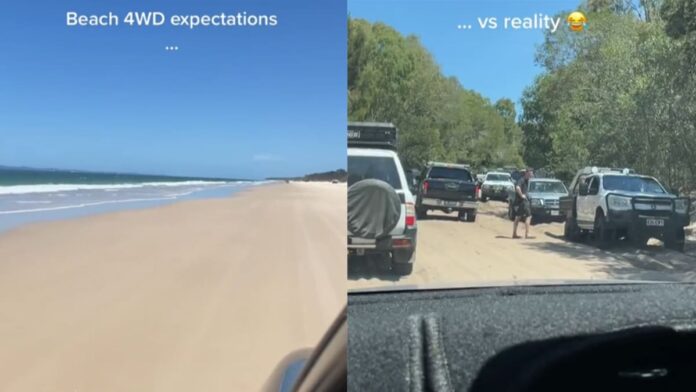[ad_1]
A TikTok video has outlined the reality of Bribie Island beach driving. So how can you avoid becoming an accidental viral sensation?

One of Australia’s most popular driving beaches is Ocean Beach on Bribie Island in Queensland. This island is 65km north of Brisbane and is accessible to holidaymakers thanks to a bridge connecting it to the mainland.
RELATED: How to drive on sand: tips and tricks
However, the beach is becoming popular with tourists and unseasoned beach drivers who are increasingly getting bogged in the sand.
It has become such an issue that a Facebook group titled ‘I got bogged at Bribie Island‘ has nearly 70,000 members.
One beachgoer recently took to TikTok to document the number of bogged cars they saw on their journey in a single day with the caption ‘every time at Bribie’.
When approaching the beach on Bribie Island, plenty of signs outline the risk of changing beach conditions, the need for preparation, and the areas where you are not to drive.
Beach driving tips
The majority of motorists stuck in the sand appear to be bogged due to not following one of the biggest rules of sand driving: pick your line carefully and go easy on the throttle.
The access road to the beach is often covered with much softer sand compared to the compacted sand on the beach. Keeping an eye out for soft patches and ensuring you’re following the tracks of other cars who have successfully travelled through that section is imperative.
Another essential rule to follow is to ensure you’re soft on your throttle. Stamping on the accelerator when sinking into loose sand will bury your wheels more.
One of the top comments on TikTok also highlights another one of the most important rules of driving on the sand: deflate your tyres.
“Lol, good ole Bribie and the 40psi club,” one commenter wrote.
This comment refers to the standard tyre pressure used when driving on tarmac roads; but unprepared motorists may overlook the importance of adjusting tyre pressures before sand driving.
Beach driving tyre pressures
Selecting the appropriate tyre pressure is important across all kinds of off-road driving, but when driving on the sand, you need to maintain the biggest tyre contact patch you can to float along on top of the sand rather than continue trudging through it.
There are many theories about the best pressure to run at, but Drive motoring journalist, Tom Fraser, found that starting at just under 20psi is a good base. Be prepared to go lower if needed.
It is also important to pick your vehicle for the journey; two-wheel-drive (2WD) vehicles, trail bikes, and motorbikes are prohibited from obtaining a vehicle access permit and entering the Bribie Island Recreation Area.
The Queensland Parks and Forests recommends that people heading to Bribie Island beaches opt for a four-wheel-drive vehicle with high ground clearance and a low-range gear option, suggesting: “Drivers should engage and stay in 4WD and adjust tyre pressure accordingly”.
Recovery is an expensive endeavour for those who can’t get out on their own. Depending on how stuck you are, calling one of the many recovery companies that operate around these areas can cost between $200 and $1500.
It’s also a good idea to check if you need a permit before you head out on the beach. Usually while applying for the permit online, there are plenty of safety warnings as well as tips and tricks on tackling the beach. Bribie Island requires a permit to drive on, which costs $55.50 for a week and $173.30 for more than one week (up to one year).
The main things to remember about driving on sand tracks or beach access roads are to lower your tyre pressures, avoid being too heavy on the throttle, and be well prepared.
The post ‘Every time’: Video shows Bribie Island beach driving chaos appeared first on Drive.
[ad_2]
Source link


